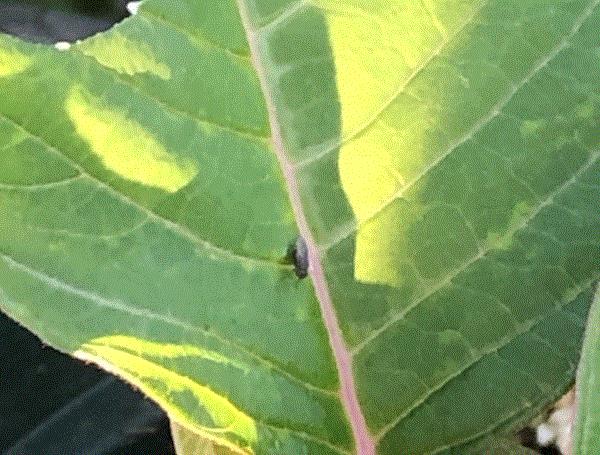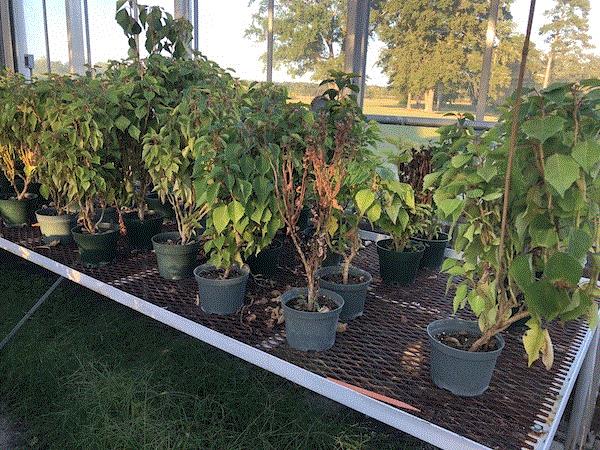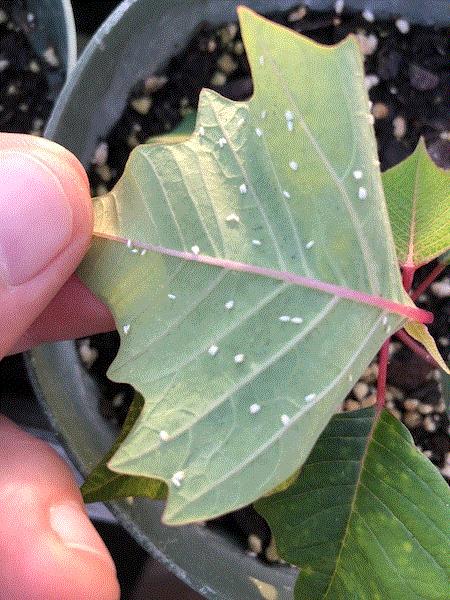Finally, bracts!
I grow a couple hundred poinsettias every year. They're grown for research on whitefly management. I don't grow presentable plants, so please cut me some slack when you see the pictures in this newsletter. These poinsettias are bug food; that’s all they are. I don't really care if they;re red, yellow, green, pink or white.
I give the decent-looking ones to my co-workers in mid-December. Think of it as greasing the wheels. I think the goodwill has resulted in someone willingly and happily helping me when my ventilation fan stops working or the truck gets stuck in the backwoods (again).
For many of you, poinsettias are bread-and-butter. At this time of the year, operations in the North are busy with houses full of colorful bracts. It’s getting close for me; some bracts are forming under the 11-hour long days. This is a good time to be mindful of some of the last-minute pest and disease issues, so y’all can finish up the 2021 crop beautifully.
I’m not a horticulturist, so I’m not qualified to yack about temperature, light, humidity, nutrients, pH and EC management during the finishing stage. (Chat with Matthew Chappell or Paul Pilon if you need help in the growing department.) I can jabber on about bugs.

Major bugs during bract formation
Bugs you should watch out for during the finishing stage are whiteflies, fungus gnats, shore flies and spider mites. If any of these pests becomes a problem during the finishing stage, it means you haven't done a good job suppressing the population in the growing stage.
“Can't use neonics” is no longer a valid reason for not being able to control whiteflies because there are several options, both spray and drench, that have efficacies comparable to Safari (dinotefuran) and Marathon (imidacloprid). Read my article on the alternatives of neonicotinoids by clicking HERE. If you're only a few days before shipping, your options may be a spray of Avid (abamectin), TriStar (acetamiprid), Safari (dinotefuran), Flagship (thiamethoxam) and Sanmite (pyridaben) to knock down the adults and some nymphs.
Fungus gnats and shore flies are problems during the growing stage, but they can persist to the finishing stage. Keeping the medium on the dry side can help with fungus gnat and shore fly problems. Sprenching the medium surface with Safari can knock down some of the adults. It’s more important to solve the problem by targeting the larvae with Citation (cyromazine), Gnatrol (the nematode Steinernema feltiae) and neonicotinoids with a sprench a couple of weeks before shipping.

I think I keep my medium a little wet.
Twospotted spider mite and Lewis mite can sometimes become problems during the finishing stage. There are quite a few miticide options, but product selection and application method make a difference in management efficacy. When canopies are dense and plants are packed tight, miticides that have translaminar activity—such as Avid, TetraSan (etoxazole) and Savate (spiromesifen)—are good options. Doesn't matter if you use a contact or translaminar miticide—achieving good and thorough coverage of all leaves goes a long way in achieving good control efficacy.

Super diseases during bract formation
Temperature, humidity and plant spacing make a lot of difference in the severity of diseases during the finishing stage. Some of the diseases I've seen inflicting poinsettias during the finishing stage include stem and root rots by Pythium and Rhizoctonia, and leaf diseases such as Botrytis and powdery mildew.
A wilted plant among a sea of good-looking plants can catch your eyes quickly. Check on the roots and stems (near the medium surface) of wilted plants to make sure these tissues aren't sunken and discolored. It’s a good idea to pull the wilted plants out immediately (don't let them become a source for more infections), and send in samples for diagnosis because several diseases can cause similar symptoms.
Management options differ depending on the causing agents, so diagnosis is critical to selecting the right fungicides. Be especially careful when selecting fungicides for Pythium and Phytophthora management after bract formation and do small-scale phytotoxicity trials to test for phytotoxicity before application.

Something is odd about that plant. I wonder what I should do.
Botrytis and powdery mildew can be especially problematic when plants are packed together. Increasing plant spacing and reducing relative humidity can help with management of these diseases. A good number of fungicides are available to manage Botrytis and powdery mildew. Mural (azoxystrobin + benzovindiflupyr), Palladium (cyprodinil + fludioxonil), Decree (fenhexamid), Medallion (fludioxonil), Milstop (potassium bicarbonate) and Pagaent Intrinsic (pyraclostrobin + boscalid) are reported to be bract-safe.

Bract-safe pesticides?
How to manage pest and disease issues effectively with pesticides or biological control agents isn't the most frequently asked question during the finishing stage. Well, at least not from those who asked me. Instead, the question is, “Is (enter product name) safe to bracts?"
Okay, here’s the answer. Are you ready? The answer is, “It depends.”
Now, don't turn beet-red and yell, “You Ph.D.s are all alike! It depends? Can't you simply answer the question?” Really, it depends.
Phytotoxicity isn't an across-the-board phenomenon. What I mean is, if burn or discoloration occurs on one cultivar, it may not happen on another cultivar. And a product that’s otherwise bract-safe at the label rate can cause plant injury when (oops!) over-applied or when tank-mixed with another product or adjuvant. A general statement such as, “Product X causes burn on poinsettia bracts,” isn’t the most accurate and responsible depiction of what Product X may or may not do. Always question what would happen to the cultivars you're growing, the rate you're using and the environmental conditions when the application is made.
The first place to start is the product label. Product labels usually list known cases of phytotocixity. For example, the label prohibits the application of the insecticide Endeavor (pymetrozine) and Hachi-Hachi (tolfenpyrad), and fungicide Daconil (chlorothalonil) to bracts. I avoid using products that are so explicit about its phytotoxicity.
Some labels are a little less certain. For example, the label of M-Pede (insecticidal soap) indicates that the product may injure poinsettia bracts. Even products with labels that didn’t indicate injury can cause phytotoxicty. I’ve seen injuries to bracts after application of BotaniGard ES (a bit more heavy-handed perhaps?) but not BotaniGard WP.
If you’re not sure after reading a product label, chat with the manufacturer’s technical service representative. If, for whatever reason, you really have to use a product even when the label explicitly indicates potential phytotoxicity on poinsettias, do me a favor and remember two things: first, do it at your own risk, and second, run a small-scale test before you go whole-hog on the application.
Manufacturers cannot test for bract safety on all poinsettia cultivars and certainly not for the many new cultivars that are introduced each year. It’s quite possible that the cultivar you're growing isn’t the one that was tested by the manufacturers. It’s always a good idea to test for bract safety by running small-scale trials.
Whenever you need to spray or drench a chemical or biological pesticide during the finishing stage, it’s always a good idea to test for bract safety on a small group of plants using your intended application rates and methods. Sacrifice six to 10 plants, spray or drench on the small group, wait a few days and see if anything weird happens to the bracts. If nothing happens, happy treatment! If the bracts or other leaves look sad, then go back to the drawing board. I know it’s an enormous investment of time and materials, but this is perhaps the best approach to avoid regrettable damage.
Of course, you could request bract safety information from your cutting suppliers. Any propagator or supplier that’s worth its salt should have tested the bract safety of major pesticides for the cultivars it provides. But, again, it’s probably a good idea to test for bract safety on your own just to make sure.
By the way, some edge burn may not always be pesticide injury. It could be calcium deficiency. Hopefully, calcium deficiency isn't an issue since you monitor pH and EC regularly from sticking to finishing. You did, right?

Really, how do folks feel about bugs on poinsettias?
We always operate under the assumption that consumers don't tolerate any bugs on poinsettias. But is that assumption true? Very little data are available to validate the assumption. In the case of whitefly, however, a study by Erfan Vafaie (formerly of Texas A&M University and now with BioWorks) and his colleagues provided some interesting observations (HortTechnology 30: 486-491).
Erfan and his colleagues visited 17 retailers (big box stores, grocery and independent florists, and garden centers) in Tyler, Texas, in 2016 and 2018, and sampled for the densities of whiteflies, quality rating and other information of the poinsettias on the shelves. The average densities of whitefly nymphs averaged four to 40 per plant among the retailers. And there didn't appear to be any difference in the whitefly densities among the retailers despite consistently higher marketability rating and price at independent florists and garden centers. So, despite the growers’ (who were in California, Canada and Texas for this study) best effort, poinsettias in retail outlets are certainly not whitefly-free.

Whitefly? What whitefly?
Here's an interesting observation: Erfan reported that the manager of the outlet with the highest whitefly densities thought the poinsettias were relatively whitefly-free. This begs the questions of whether retailers can recognize whitefly infestation and whether the assumption of zero tolerance is valid.
This is but one observation, so we’ll need many more similar studies on multiple pest species before a general conclusion can be made. Pest management on ornamental plants involves not just the growers, the pests and the plants, but also the consumers. It's the latter that’s going to make the validation of the “zero-tolerance” assumption interesting and difficult.




See y'all later!

JC Chong
Professor of Entomology at Clemson University
This e-mail received by 26,766 subscribers like you!
If you're interested in advertising on PestTalks contact Kim Brown ASAP!